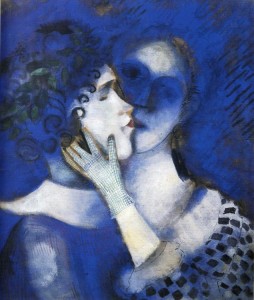 I was 12 when I saw my first Chagall. Walking down Dizengoff Street in Tel Aviv. Ice cream in hand, I stopped short. In the window of a gallery, a magical painting took my breath away.
I was 12 when I saw my first Chagall. Walking down Dizengoff Street in Tel Aviv. Ice cream in hand, I stopped short. In the window of a gallery, a magical painting took my breath away.
I got my first taste of an original Chagall.
The memory is so vivid, I can recall it in detail. I stood there, mesmerized by the indescribable beauty, the depth of emotion and passion. We just learnt at school about the pogroms in the Russian Shteitels, and they were deeply disturbing to me.
I remember standing in front of that window for what seemed like an eternity. I became one with the soaring figures, transported to the little village below. Then, hugely embarrassed, I burst into tears.
The colors were magnificent, the couple, in flight, fueled by love. Yet down below, reality awaited them, but they were momentarily oblivious. I had a huge lump in my throat for these lovers who floated in space to unite with a kiss, despite, strangely, being tethered to the ground.
Could have all been my very own interpretation, but all told, I became obsessed.
I began to seek out everything I could on the artist and his masterpieces.
Mark Zacharov Chagall, a Russian-French artist (1887-1985) was referred to by famous art critics as “The quintessential Jewish painter of the twentieth century”.
I found that many think of Marc Chagall as the creator of folksy figures soaring above old world villages, surrounded by ghostly fiddles, big colorful bouquets and animated animals. Art critics have knocked him for being too sentimental or capricious. Regardless, Chagall became iconic for his mastery of color, myth and spiritual tradition.
But what caught me that very first time, (though I don’t believe I could have verbalized it) was the darker aspect of this master, making a political, even pessimistic statement, all while imbuing the image with magic and fantasy.
Nevertheless, during his time of exile during 2nd World War, he made a name for himself, blending techniques of Surrealism, Cubism, Fauvism, influenced by Russian artistic traditions. He was proud of of his Jewishness, his early life in the picturesque Vitebsk, his Hassidic roots. Chagall used symbolism to honor his parents ,to cherish and publicly express his Jewish roots by integrating them into his art. For Chagall, this was also his means of “self-assertion and an expression of principle.”
He fled with his wife Bella and daughter Ida following the Russian Revolution and his works, though imbued with fantasy, reflect the underlying sense of painful unrest, the result of his uprooting. The colors he used during this period, grays, blacks, blues and a surprising violent streak of red, which are in contrast to his normal palette, casting a dark shadow over life in Paris.
Yet the Jewish spirit is evident in all the works….even the most political pieces are expressed thru fantasy, like the grandfather clock with the case of the itters or the the rooster in evening attire.
Chaggal is quoted saying “Without mystical element, is there a single great picture, a single great poem – or even- a a single great social movement?
He worked in every possible medium, oil, glass, ceramic book illustrations and tapestries.
His stained glass windows grace the cathedrals of Reims and Metz, the Windows for the UN, and the Jerusalem Windows, in Israel.
The Paris Opera house’s ceiling is decorated with an exquisite large scale painting by the artist.
In 1941, as the Nazis became pervasive, Chagall moved to New York City with his family, driving him further away from the village existence he knew and loved. Religious imagery,of the dark and violent kind reappeared constantly throughout Chagall’s paintings, communicating his suffering. In 1944 Chagall’s wife suddenly passed away, driving his artistic vision into even darker and more confused territory. Though he remarried quickly, the longing for his true love was evident in the works he produced.
Marc Chagall is the most fascinating artist, always expressing his deeply-felt Jewish spirit in his art, catching the observer in the deepest place, where the heart lives.
